GDN3985 Evidence-Based Practice: PICO(T) Question & Search Report
VerifiedAdded on 2023/04/25
|9
|1680
|450
Report
AI Summary
This report focuses on developing a PICO(T) question and implementing literature search strategies to investigate the effectiveness of music therapy for pain relief in post-operative patients in the Post-Anesthesia Care Unit (PACU). The report begins by highlighting the drawbacks of relying solely on pharmacological methods for pain management, such as analgesic drugs, and introduces music therapy as a non-pharmacological alternative. It then outlines the PICO(T) framework (Patient/Population, Intervention, Comparison, Outcome, Time), detailing how to construct a well-defined clinical question. The methodology involves defining the problem, searching clinical literature, appraising evidence, applying evidence with clinical expertise, and evaluating outcomes. The report includes tables illustrating the PICO(T) components related to the research question and the database search methodology. It uses the Trip database and presents relevant search results, concluding that music therapy can effectively reduce post-operative pain and anxiety. The assignment emphasizes the importance of evidence-based practice and continuous learning for nurses.

Running head: Assessment 2 – Development of PICO (T) question and
literature search strategies
1
DEVELOPMENT OF PICO (T) QUESTION AND LITERATURE SEARCH STRATEGIES
Author Name(s), First M. Last, Omit Titles and Degrees
Institutional Affiliation(s)
literature search strategies
1
DEVELOPMENT OF PICO (T) QUESTION AND LITERATURE SEARCH STRATEGIES
Author Name(s), First M. Last, Omit Titles and Degrees
Institutional Affiliation(s)
Paraphrase This Document
Need a fresh take? Get an instant paraphrase of this document with our AI Paraphraser
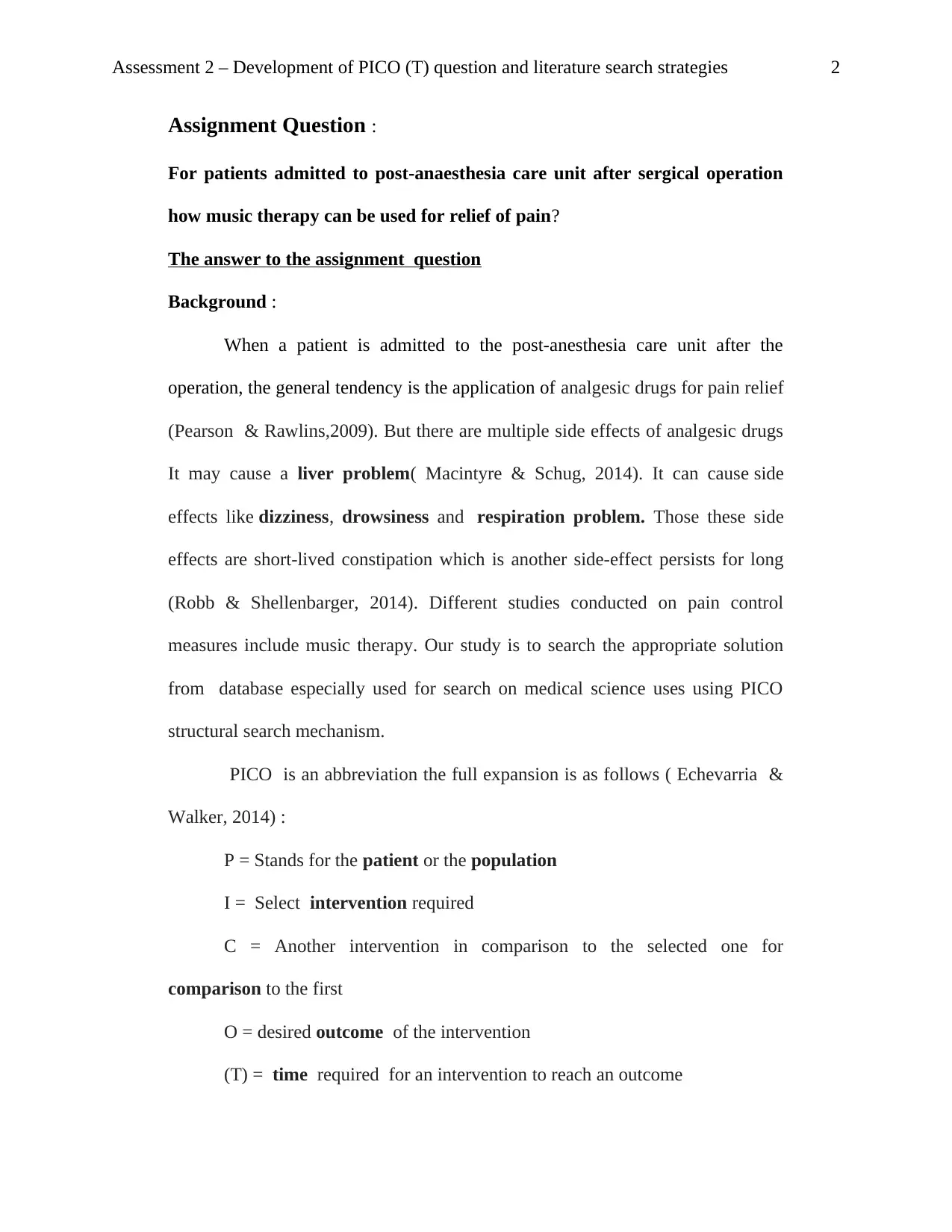
Assessment 2 – Development of PICO (T) question and literature search strategies 2
Assignment Question :
For patients admitted to post-anaesthesia care unit after sergical operation
how music therapy can be used for relief of pain?
The answer to the assignment question
Background :
When a patient is admitted to the post-anesthesia care unit after the
operation, the general tendency is the application of analgesic drugs for pain relief
(Pearson & Rawlins,2009). But there are multiple side effects of analgesic drugs
It may cause a liver problem( Macintyre & Schug, 2014). It can cause side
effects like dizziness, drowsiness and respiration problem. Those these side
effects are short-lived constipation which is another side-effect persists for long
(Robb & Shellenbarger, 2014). Different studies conducted on pain control
measures include music therapy. Our study is to search the appropriate solution
from database especially used for search on medical science uses using PICO
structural search mechanism.
PICO is an abbreviation the full expansion is as follows ( Echevarria &
Walker, 2014) :
P = Stands for the patient or the population
I = Select intervention required
C = Another intervention in comparison to the selected one for
comparison to the first
O = desired outcome of the intervention
(T) = time required for an intervention to reach an outcome
Assignment Question :
For patients admitted to post-anaesthesia care unit after sergical operation
how music therapy can be used for relief of pain?
The answer to the assignment question
Background :
When a patient is admitted to the post-anesthesia care unit after the
operation, the general tendency is the application of analgesic drugs for pain relief
(Pearson & Rawlins,2009). But there are multiple side effects of analgesic drugs
It may cause a liver problem( Macintyre & Schug, 2014). It can cause side
effects like dizziness, drowsiness and respiration problem. Those these side
effects are short-lived constipation which is another side-effect persists for long
(Robb & Shellenbarger, 2014). Different studies conducted on pain control
measures include music therapy. Our study is to search the appropriate solution
from database especially used for search on medical science uses using PICO
structural search mechanism.
PICO is an abbreviation the full expansion is as follows ( Echevarria &
Walker, 2014) :
P = Stands for the patient or the population
I = Select intervention required
C = Another intervention in comparison to the selected one for
comparison to the first
O = desired outcome of the intervention
(T) = time required for an intervention to reach an outcome

Assessment 2 – Development of PICO (T) question and literature search strategies 3
The step one of the process would be to develop an answerable clinical
question. The type of clinical questions are of two types; background questions
and foreground questions.
Background questions are questions that apply to the clinical condition for
all patients and are intended for the whole world (for example how to reduce pain
after removal of tooth and how long it will take to cure?). These types of
questions does not require specialized knowledge about a disorder and often
include a root of the question by using the words who, what, where, when, how,
why with a verb (which causes).
Foreground questions are for a specific patient and answers are provided
that can directly improve a result which is important to the patient. Foreground
issues are associated with information regarding the patient / problem, the
intervention of interest, a potentially comparable intervention and the finding of
the outcome of interest ( Effectiveness of music therapy as pain controlling
measure compared to pain-killer like analgesic drugs after surgery of a patient).
Foreground questions concepts are used while framing questionnaire using the
PICO format.
Using the PICO format the search can be conducted using all the first four
parameters using an operator. If the number of results is very limited we can
modify the search using the first three parameters. For that, the search
questionnaire is to be amended and the search is conducted using the
questionnaire from the database. The system can be represented in a tabular form
as per table 1.
The step one of the process would be to develop an answerable clinical
question. The type of clinical questions are of two types; background questions
and foreground questions.
Background questions are questions that apply to the clinical condition for
all patients and are intended for the whole world (for example how to reduce pain
after removal of tooth and how long it will take to cure?). These types of
questions does not require specialized knowledge about a disorder and often
include a root of the question by using the words who, what, where, when, how,
why with a verb (which causes).
Foreground questions are for a specific patient and answers are provided
that can directly improve a result which is important to the patient. Foreground
issues are associated with information regarding the patient / problem, the
intervention of interest, a potentially comparable intervention and the finding of
the outcome of interest ( Effectiveness of music therapy as pain controlling
measure compared to pain-killer like analgesic drugs after surgery of a patient).
Foreground questions concepts are used while framing questionnaire using the
PICO format.
Using the PICO format the search can be conducted using all the first four
parameters using an operator. If the number of results is very limited we can
modify the search using the first three parameters. For that, the search
questionnaire is to be amended and the search is conducted using the
questionnaire from the database. The system can be represented in a tabular form
as per table 1.
⊘ This is a preview!⊘
Do you want full access?
Subscribe today to unlock all pages.

Trusted by 1+ million students worldwide
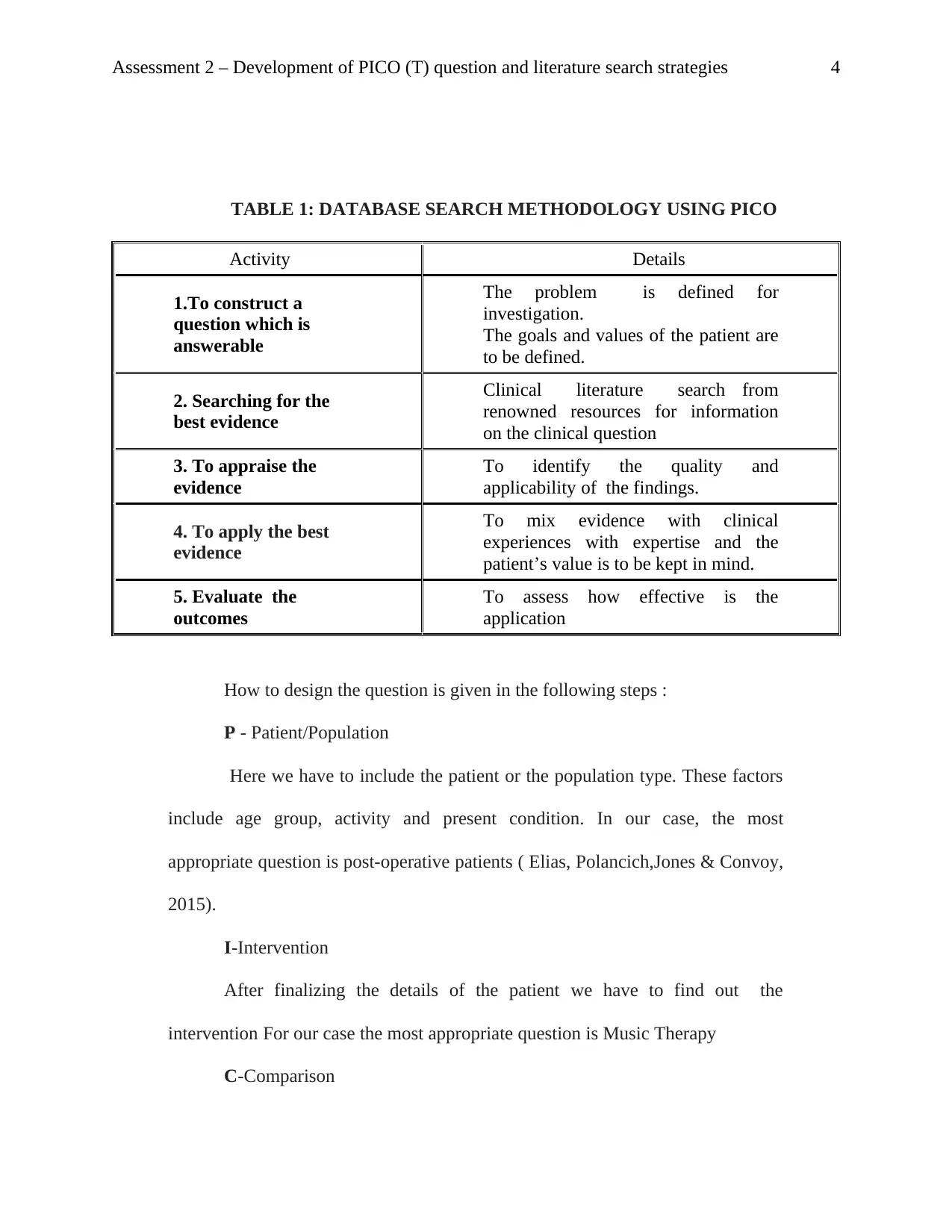
Assessment 2 – Development of PICO (T) question and literature search strategies 4
TABLE 1: DATABASE SEARCH METHODOLOGY USING PICO
Activity Details
1.To construct a
question which is
answerable
The problem is defined for
investigation.
The goals and values of the patient are
to be defined.
2. Searching for the
best evidence
Clinical literature search from
renowned resources for information
on the clinical question
3. To appraise the
evidence
To identify the quality and
applicability of the findings.
4. To apply the best
evidence
To mix evidence with clinical
experiences with expertise and the
patient’s value is to be kept in mind.
5. Evaluate the
outcomes
To assess how effective is the
application
How to design the question is given in the following steps :
P - Patient/Population
Here we have to include the patient or the population type. These factors
include age group, activity and present condition. In our case, the most
appropriate question is post-operative patients ( Elias, Polancich,Jones & Convoy,
2015).
I-Intervention
After finalizing the details of the patient we have to find out the
intervention For our case the most appropriate question is Music Therapy
C-Comparison
TABLE 1: DATABASE SEARCH METHODOLOGY USING PICO
Activity Details
1.To construct a
question which is
answerable
The problem is defined for
investigation.
The goals and values of the patient are
to be defined.
2. Searching for the
best evidence
Clinical literature search from
renowned resources for information
on the clinical question
3. To appraise the
evidence
To identify the quality and
applicability of the findings.
4. To apply the best
evidence
To mix evidence with clinical
experiences with expertise and the
patient’s value is to be kept in mind.
5. Evaluate the
outcomes
To assess how effective is the
application
How to design the question is given in the following steps :
P - Patient/Population
Here we have to include the patient or the population type. These factors
include age group, activity and present condition. In our case, the most
appropriate question is post-operative patients ( Elias, Polancich,Jones & Convoy,
2015).
I-Intervention
After finalizing the details of the patient we have to find out the
intervention For our case the most appropriate question is Music Therapy
C-Comparison
Paraphrase This Document
Need a fresh take? Get an instant paraphrase of this document with our AI Paraphraser
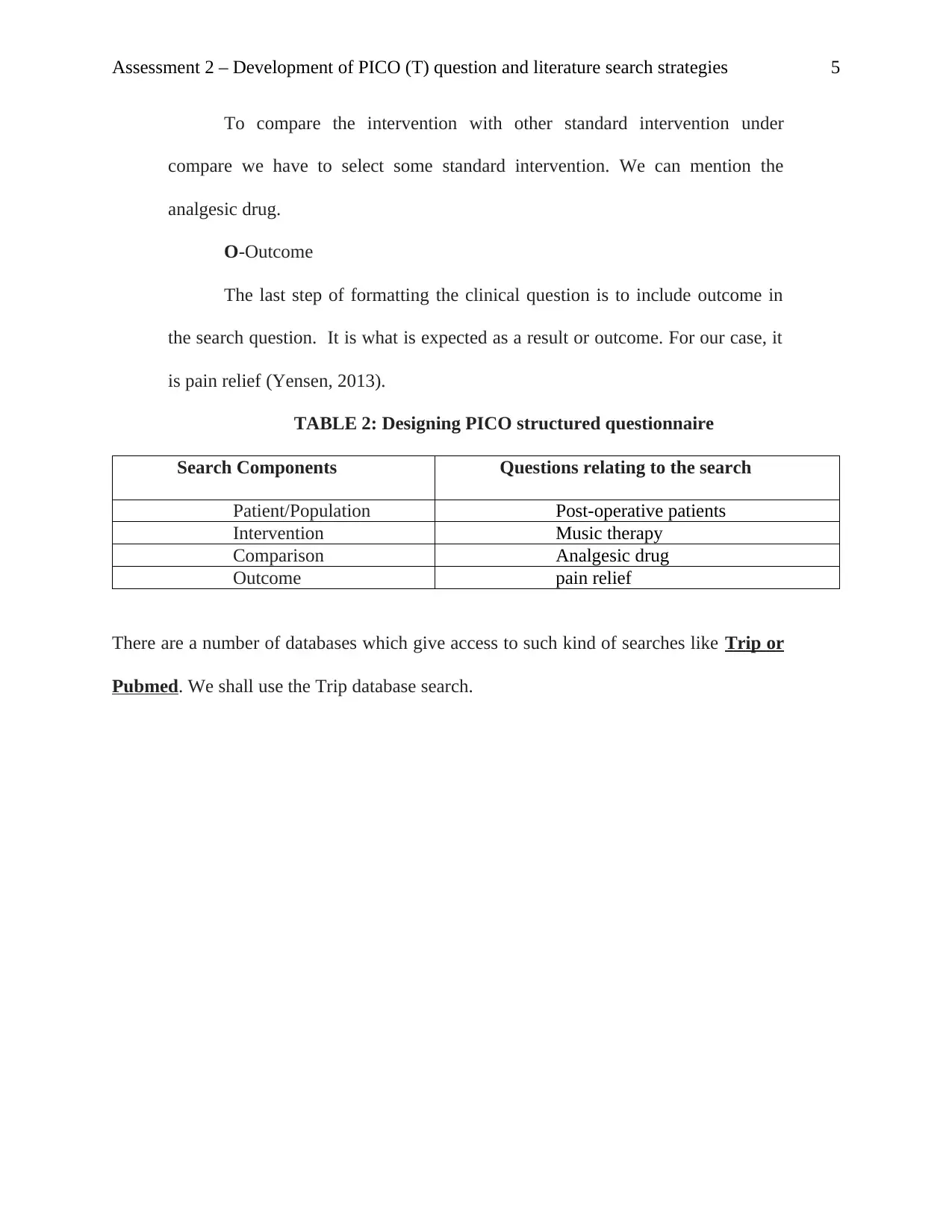
Assessment 2 – Development of PICO (T) question and literature search strategies 5
To compare the intervention with other standard intervention under
compare we have to select some standard intervention. We can mention the
analgesic drug.
O-Outcome
The last step of formatting the clinical question is to include outcome in
the search question. It is what is expected as a result or outcome. For our case, it
is pain relief (Yensen, 2013).
TABLE 2: Designing PICO structured questionnaire
Search Components Questions relating to the search
Patient/Population Post-operative patients
Intervention Music therapy
Comparison Analgesic drug
Outcome pain relief
There are a number of databases which give access to such kind of searches like Trip or
Pubmed. We shall use the Trip database search.
To compare the intervention with other standard intervention under
compare we have to select some standard intervention. We can mention the
analgesic drug.
O-Outcome
The last step of formatting the clinical question is to include outcome in
the search question. It is what is expected as a result or outcome. For our case, it
is pain relief (Yensen, 2013).
TABLE 2: Designing PICO structured questionnaire
Search Components Questions relating to the search
Patient/Population Post-operative patients
Intervention Music therapy
Comparison Analgesic drug
Outcome pain relief
There are a number of databases which give access to such kind of searches like Trip or
Pubmed. We shall use the Trip database search.
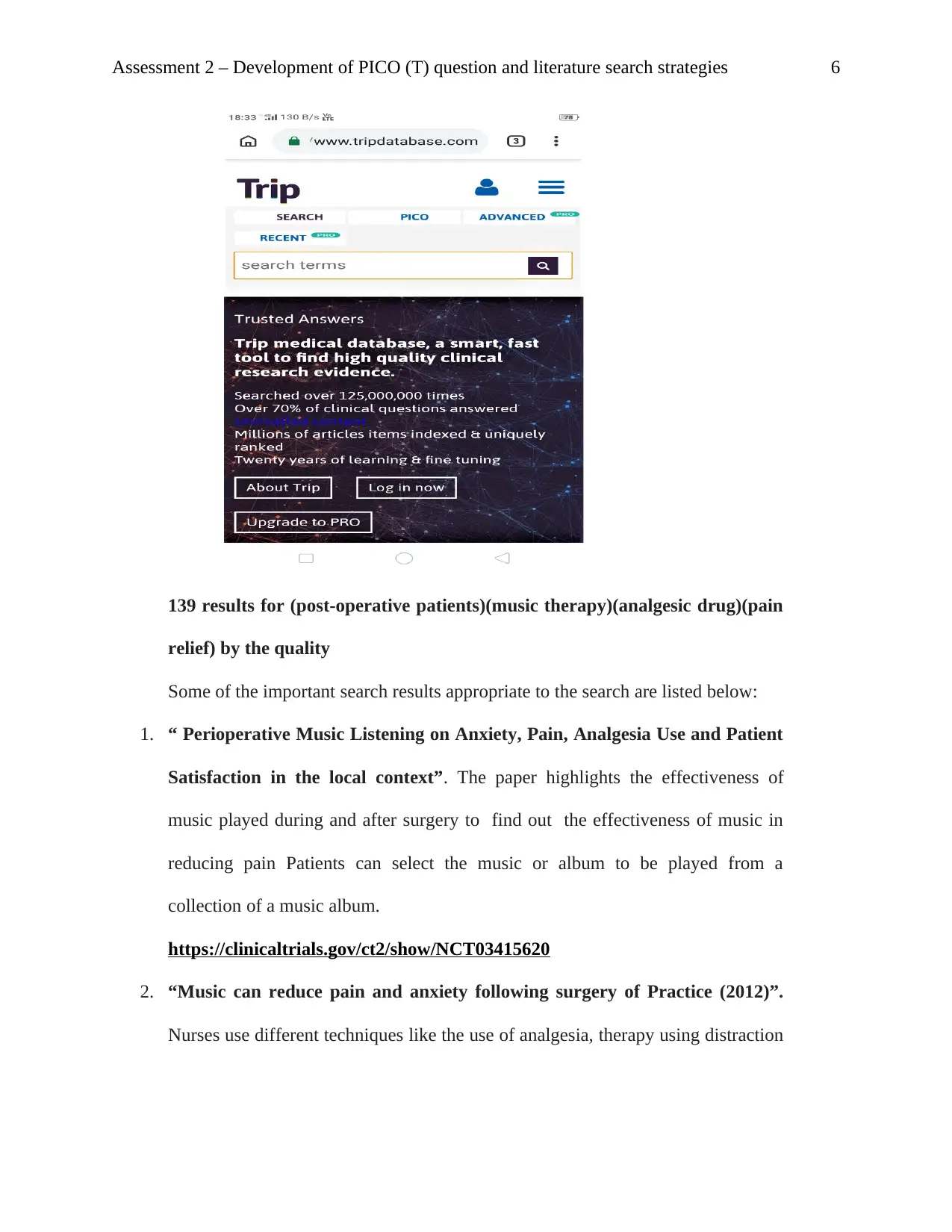
Assessment 2 – Development of PICO (T) question and literature search strategies 6
139 results for (post-operative patients)(music therapy)(analgesic drug)(pain
relief) by the quality
Some of the important search results appropriate to the search are listed below:
1. “ Perioperative Music Listening on Anxiety, Pain, Analgesia Use and Patient
Satisfaction in the local context”. The paper highlights the effectiveness of
music played during and after surgery to find out the effectiveness of music in
reducing pain Patients can select the music or album to be played from a
collection of a music album.
https://clinicaltrials.gov/ct2/show/NCT03415620
2. “Music can reduce pain and anxiety following surgery of Practice (2012)”.
Nurses use different techniques like the use of analgesia, therapy using distraction
139 results for (post-operative patients)(music therapy)(analgesic drug)(pain
relief) by the quality
Some of the important search results appropriate to the search are listed below:
1. “ Perioperative Music Listening on Anxiety, Pain, Analgesia Use and Patient
Satisfaction in the local context”. The paper highlights the effectiveness of
music played during and after surgery to find out the effectiveness of music in
reducing pain Patients can select the music or album to be played from a
collection of a music album.
https://clinicaltrials.gov/ct2/show/NCT03415620
2. “Music can reduce pain and anxiety following surgery of Practice (2012)”.
Nurses use different techniques like the use of analgesia, therapy using distraction
⊘ This is a preview!⊘
Do you want full access?
Subscribe today to unlock all pages.

Trusted by 1+ million students worldwide
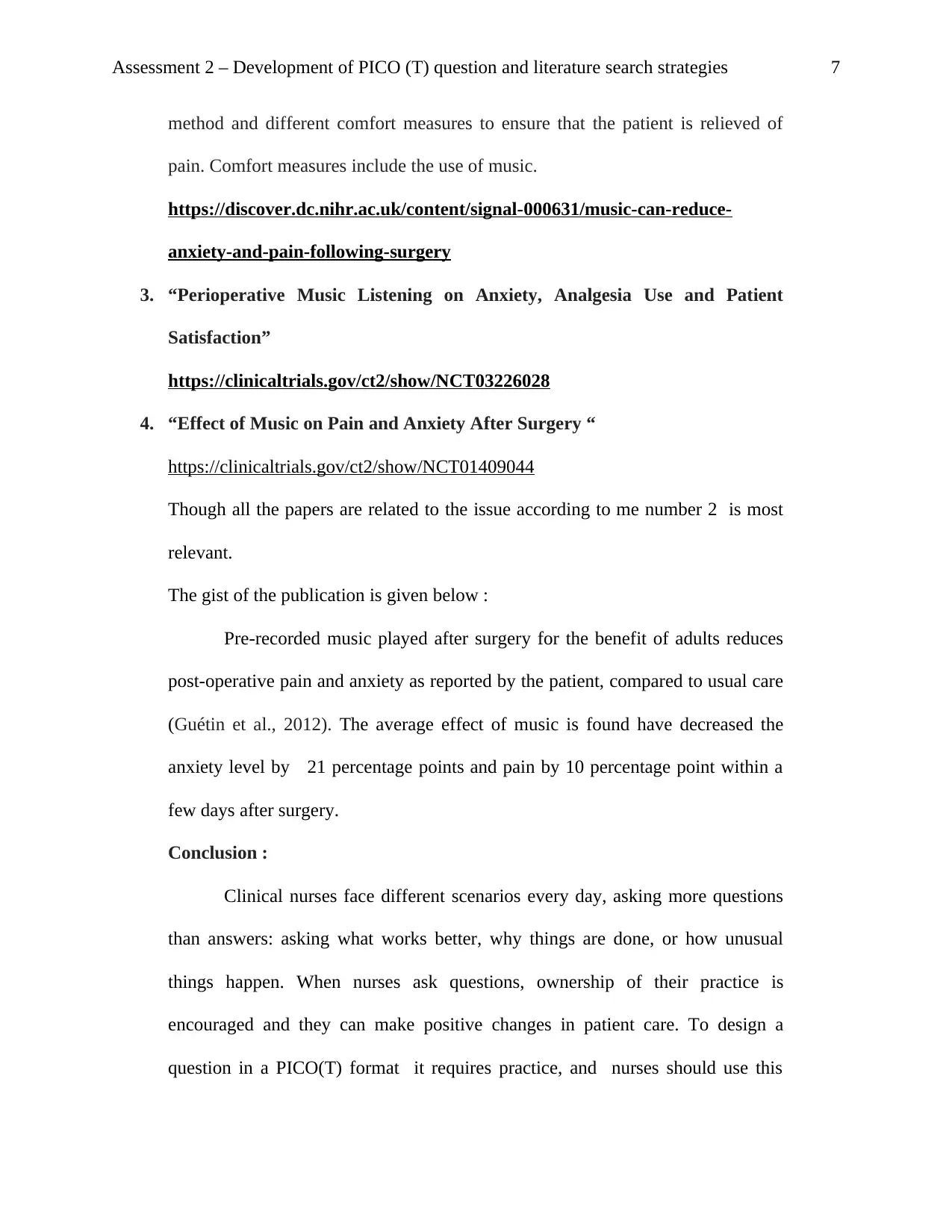
Assessment 2 – Development of PICO (T) question and literature search strategies 7
method and different comfort measures to ensure that the patient is relieved of
pain. Comfort measures include the use of music.
https://discover.dc.nihr.ac.uk/content/signal-000631/music-can-reduce-
anxiety-and-pain-following-surgery
3. “Perioperative Music Listening on Anxiety, Analgesia Use and Patient
Satisfaction”
https://clinicaltrials.gov/ct2/show/NCT03226028
4. “Effect of Music on Pain and Anxiety After Surgery “
https://clinicaltrials.gov/ct2/show/NCT01409044
Though all the papers are related to the issue according to me number 2 is most
relevant.
The gist of the publication is given below :
Pre-recorded music played after surgery for the benefit of adults reduces
post-operative pain and anxiety as reported by the patient, compared to usual care
(Guétin et al., 2012). The average effect of music is found have decreased the
anxiety level by 21 percentage points and pain by 10 percentage point within a
few days after surgery.
Conclusion :
Clinical nurses face different scenarios every day, asking more questions
than answers: asking what works better, why things are done, or how unusual
things happen. When nurses ask questions, ownership of their practice is
encouraged and they can make positive changes in patient care. To design a
question in a PICO(T) format it requires practice, and nurses should use this
method and different comfort measures to ensure that the patient is relieved of
pain. Comfort measures include the use of music.
https://discover.dc.nihr.ac.uk/content/signal-000631/music-can-reduce-
anxiety-and-pain-following-surgery
3. “Perioperative Music Listening on Anxiety, Analgesia Use and Patient
Satisfaction”
https://clinicaltrials.gov/ct2/show/NCT03226028
4. “Effect of Music on Pain and Anxiety After Surgery “
https://clinicaltrials.gov/ct2/show/NCT01409044
Though all the papers are related to the issue according to me number 2 is most
relevant.
The gist of the publication is given below :
Pre-recorded music played after surgery for the benefit of adults reduces
post-operative pain and anxiety as reported by the patient, compared to usual care
(Guétin et al., 2012). The average effect of music is found have decreased the
anxiety level by 21 percentage points and pain by 10 percentage point within a
few days after surgery.
Conclusion :
Clinical nurses face different scenarios every day, asking more questions
than answers: asking what works better, why things are done, or how unusual
things happen. When nurses ask questions, ownership of their practice is
encouraged and they can make positive changes in patient care. To design a
question in a PICO(T) format it requires practice, and nurses should use this
Paraphrase This Document
Need a fresh take? Get an instant paraphrase of this document with our AI Paraphraser
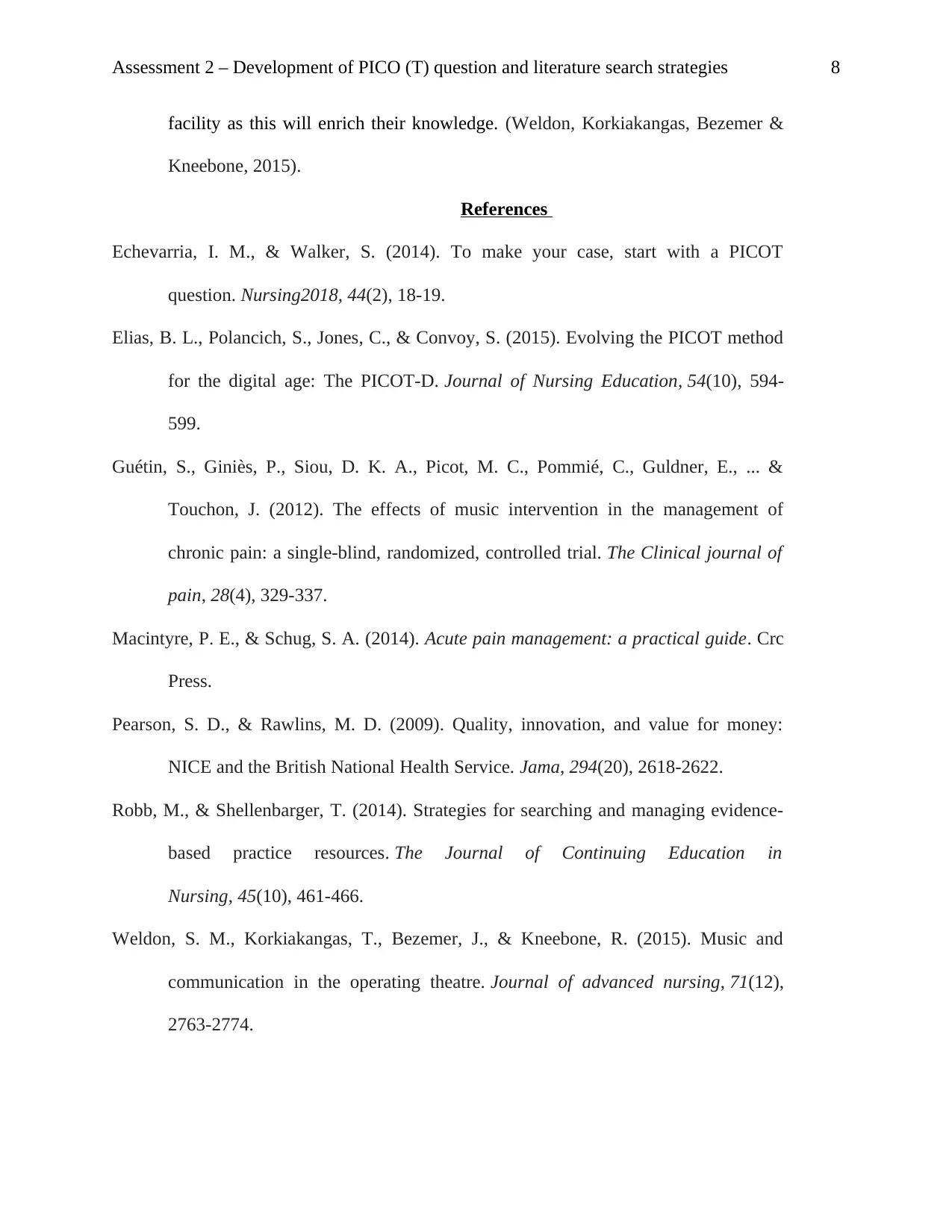
Assessment 2 – Development of PICO (T) question and literature search strategies 8
facility as this will enrich their knowledge. (Weldon, Korkiakangas, Bezemer &
Kneebone, 2015).
References
Echevarria, I. M., & Walker, S. (2014). To make your case, start with a PICOT
question. Nursing2018, 44(2), 18-19.
Elias, B. L., Polancich, S., Jones, C., & Convoy, S. (2015). Evolving the PICOT method
for the digital age: The PICOT-D. Journal of Nursing Education, 54(10), 594-
599.
Guétin, S., Giniès, P., Siou, D. K. A., Picot, M. C., Pommié, C., Guldner, E., ... &
Touchon, J. (2012). The effects of music intervention in the management of
chronic pain: a single-blind, randomized, controlled trial. The Clinical journal of
pain, 28(4), 329-337.
Macintyre, P. E., & Schug, S. A. (2014). Acute pain management: a practical guide. Crc
Press.
Pearson, S. D., & Rawlins, M. D. (2009). Quality, innovation, and value for money:
NICE and the British National Health Service. Jama, 294(20), 2618-2622.
Robb, M., & Shellenbarger, T. (2014). Strategies for searching and managing evidence-
based practice resources. The Journal of Continuing Education in
Nursing, 45(10), 461-466.
Weldon, S. M., Korkiakangas, T., Bezemer, J., & Kneebone, R. (2015). Music and
communication in the operating theatre. Journal of advanced nursing, 71(12),
2763-2774.
facility as this will enrich their knowledge. (Weldon, Korkiakangas, Bezemer &
Kneebone, 2015).
References
Echevarria, I. M., & Walker, S. (2014). To make your case, start with a PICOT
question. Nursing2018, 44(2), 18-19.
Elias, B. L., Polancich, S., Jones, C., & Convoy, S. (2015). Evolving the PICOT method
for the digital age: The PICOT-D. Journal of Nursing Education, 54(10), 594-
599.
Guétin, S., Giniès, P., Siou, D. K. A., Picot, M. C., Pommié, C., Guldner, E., ... &
Touchon, J. (2012). The effects of music intervention in the management of
chronic pain: a single-blind, randomized, controlled trial. The Clinical journal of
pain, 28(4), 329-337.
Macintyre, P. E., & Schug, S. A. (2014). Acute pain management: a practical guide. Crc
Press.
Pearson, S. D., & Rawlins, M. D. (2009). Quality, innovation, and value for money:
NICE and the British National Health Service. Jama, 294(20), 2618-2622.
Robb, M., & Shellenbarger, T. (2014). Strategies for searching and managing evidence-
based practice resources. The Journal of Continuing Education in
Nursing, 45(10), 461-466.
Weldon, S. M., Korkiakangas, T., Bezemer, J., & Kneebone, R. (2015). Music and
communication in the operating theatre. Journal of advanced nursing, 71(12),
2763-2774.

Assessment 2 – Development of PICO (T) question and literature search strategies 9
Yensen, J. (2013). PICO search strategies. Online Journal of Nursing Informatics
(OJNI), 17(3).
Yensen, J. (2013). PICO search strategies. Online Journal of Nursing Informatics
(OJNI), 17(3).
⊘ This is a preview!⊘
Do you want full access?
Subscribe today to unlock all pages.

Trusted by 1+ million students worldwide
1 out of 9
Related Documents
Your All-in-One AI-Powered Toolkit for Academic Success.
+13062052269
info@desklib.com
Available 24*7 on WhatsApp / Email
![[object Object]](/_next/static/media/star-bottom.7253800d.svg)
Unlock your academic potential
Copyright © 2020–2025 A2Z Services. All Rights Reserved. Developed and managed by ZUCOL.





